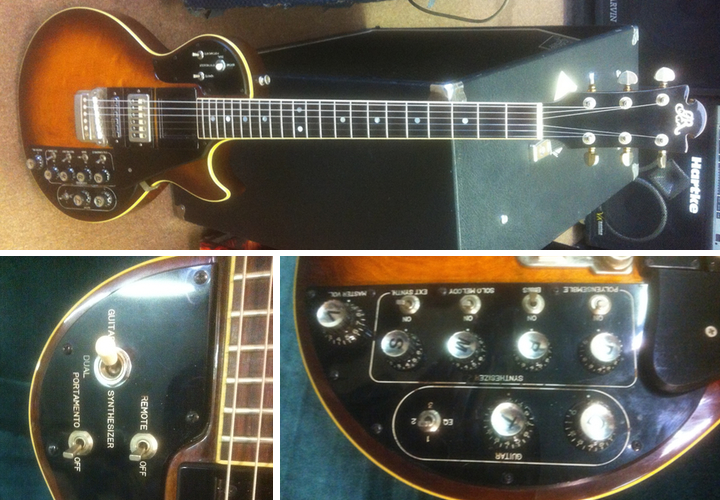Some guitars come around and totally change the landscape of the industry. The Telecaster, the ES-335, and early Martin dreadnoughts all had a far-reaching influence on the way guitars are built. But then there are other guitar innovations that make a less immediate impact. Some take a longer time for their influence to percolate, while others are barely noticed during their production.
Take a look at some of most innovative guitar and bass concepts we've seen for sale on the site.
Electra MPC Series
Before the Line 6 Variax and Gibson Firebird X, there was the Electra MPC or Modular Powered Circuits series. These guitars were built in Japan in the ‘70s, and used Atari-like cartridges to add effects to the circuit. There were 12 modules in total including standards like Phase Shifter and Octave Box, along with something called “Frog Nose.”
Perhaps the most unique MPC guitar was the double cutaway Outlaw seen here. While many Electra guitars were unabashed copies of Gibsons, the Outlaw’s shape and use of the MPC system makes it a truly unique guitar.
Alembic Basses
It’s difficult to overstate the impact the crew at Alembic had on the course of the bass guitar. Initially working as a workshop to upgrade instruments for the likes of the Grateful Dead and the Jefferson Airplane, Alembic can claim responsibility for the first successful active electronic, first graphite neck, as well as the first modern-style five string bass. Alembic was also one of the first firms to embrace the use of exoctic woods in its instruments such as Zebrawood and Purpleheart.
The combination of exotic wood selection with active electronics and unconventional materials laid the groundwork for countless custom, high-end bass designers to come.
Ovation Acoustic Electrics
Admittedly, unlike other guitars on this list, Ovation acoustics did make an immediate splash with their innovative acoustic-electric system in the late '60s and early '70s. These guitars were in effect the first widely embraced acoustic-electrics thanks to the combination of a state-of-the-art under-saddle transducer pickup and the shallow bowl-backed design which drastically reduced feedback.
According to Ovation lore, the development of the new system was the direct result of a request from Glen Campbell, Ovation's primary endorser at the time. But Ovation guitars were no strangers to radical innovation. The now iconic composite Lyrachord guitar backs, for example, grew out of Ovation founder Charles Kaman's decades of experience designing and manufacturing helicopter blades.
Fender Bass V
Well before Alembic and other brands expanding the low-end of bassists with an added low B sting, Fender produced an earlier take on the concept of a five string bass. Released in 1965, just a decade and a half after the first Precision Bass, the Bass V added a high C string to give bassists more room to work on the top-end. While it looks short-scale, the Bass V actually had a normal 34-inch scale length, but with only 15 frets. This made it somewhat awkward to play, and the instrument was never widely used during its brief run between 1965 and 1969.
Epiphone Professional Outfit
Just look at the all the knobs and switches on the unique semi-hollowbody from just five years after Gibson took over Epiphone production. The Epiphone Professional was a packaged guitar and amp pair that was produced from 1962 to 1964. The amp itself lacks any knobs of its own, and is entirely controlled by the guitar by way of a rudimentary five-prong cable. For collectors looking for an Epiphone Professional model, a complete set with the amp and guitar can be worth up to twice as much as just the guitar by itself.
Roland GS-500
The GS-500 kicked off Roland's long history of pairing cutting-edge synthesizer technology with guitars that carried through the sharkfin G-707 of the '80s and the more recent VG collaborations with Fender. Released in 1977, the GS-500 guitar controller was built by the FujiGen factory that also built Ibanez and Greco guitars in this era. The guitar was paired with the GR-500 synthesizer and its many parameters were controllable from the guitar itself. The GS-500 also featured a patented infinite sustain pickup, a concept that's been revisited by a number of companies including Moog and Fernandes.
For more info on the GS-500, this page is an incredible resource.

Wandre Aluminum Necks
In the late ‘70s, Travis Bean (and later Kramer) built brands around the concept of aluminum-necked guitars. In the late ‘60s, Musicraft Company out of San Francisco introduced a few short-lived models made completely of aluminum. But before that, there were Wandre guitars and basses, built in Italy in the early ‘60s and featuring aluminum necks, unique hardware, and a overwhelming amount of vintage mojo.






